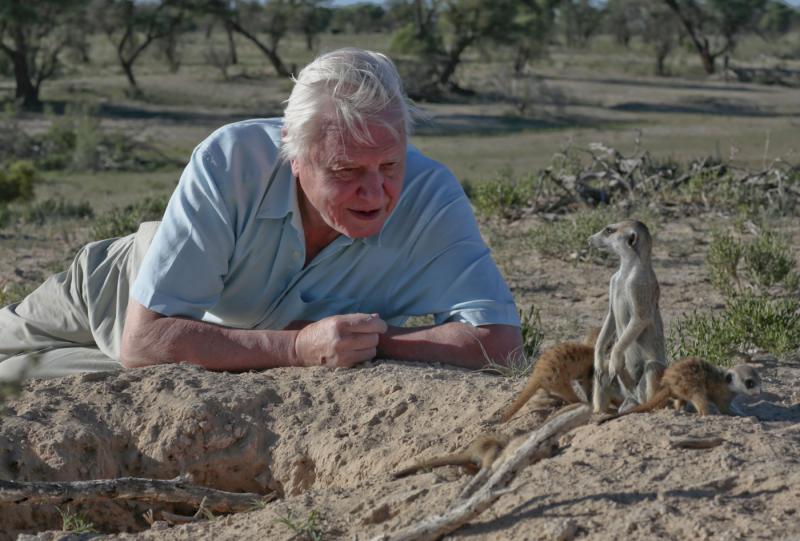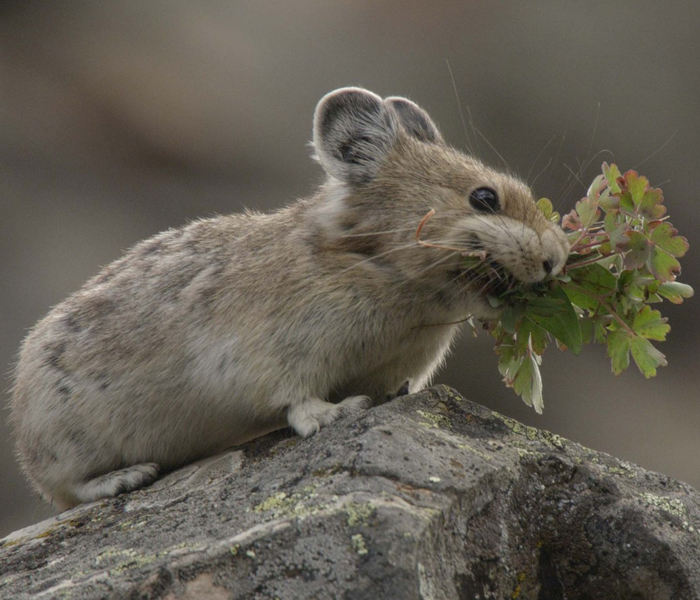Life Story, BBC One | reviews, news & interviews
Life Story, BBC One
Life Story, BBC One
How creatures great and small cope with their own housing crises

David Attenborough’s characteristically soothing narration again described the unceasing struggle for survival in the animal world. In astonishing films from all over the world, we witnessed an enormous variety of tactics for finding homes that not only provided shelter, but protection. In nature, he told us, good homes are all too rare, and we were treated to some not-so-subtle allusions to our own housing crises.
This episode, subtitled Home, opened by visiting a bushy glade in the huge Zambian plain where a dozen wild dog pups were guarded by an adult male babysitter, as the other adults of the pack were out on the hunt. Danger appeared in the form of an eight-foot python, perfectly capable of swallowing a pup. The adult canine had to decide whether to stay put or lead his troop away, both dangerous options. As the python slithered into the pups’ burrow, Mr Babysitter successfully led his charges to another natural shelter.
 A chimpanzee group living on the edge of the Sahara in Senegal had to be led by the dominant male – in 50 degree heat – on a 10 mile search for water, at the height of the drought. The eldest of the group knew to dig down for water in a dry river bed, showing the others what to do. Here there was no fixed home, but an intimate knowledge of the territory made survival possible.
A chimpanzee group living on the edge of the Sahara in Senegal had to be led by the dominant male – in 50 degree heat – on a 10 mile search for water, at the height of the drought. The eldest of the group knew to dig down for water in a dry river bed, showing the others what to do. Here there was no fixed home, but an intimate knowledge of the territory made survival possible.
During the winter, mountain goats (pictured above) lived high up in the North American Rockies, safe from predators, but their seasonal home did not provide the mineral salts their bodies needed. In the spring, we watched a yearling goat, on his own for the first time, delicately descend the precipitous mountainside, cross a snow-melt raging river, and feed on the vital salt deposits. A grizzly bear hoved menacingly into view but went off – whew! – in another direction.
Hermit crabs lined up on a remote Caribbean island to move themselves from shell to shell as they grew; if they could not find an appropriate shell they would burn to death under the unforgiving tropical sun. The crabs formed an orderly queue, from big to little, handing down the shells by size; was this by implication a model for human househunting? The smallest hermit crab lost out, though, gazumped by a slightly larger crab that shoved him aside.
 Remora fish, in the sea off Fiji, attached themselves by suckers to passing sharks and huge manta rays. In return for living on their mobile homes, over which they have no control, they consume the parasites attached to the host fish. Back in the Rockies, American pika, alert and chuntering small rodents (pictured left), have to find safe shelter in which to store the plants which bloom in the short summer, to see them through the winter. They worked like maniacs, running scores of miles, and even stealing from each other. One watched in despair as mountain sheep ate her precious store, which wasn't safely enough concealed.
Remora fish, in the sea off Fiji, attached themselves by suckers to passing sharks and huge manta rays. In return for living on their mobile homes, over which they have no control, they consume the parasites attached to the host fish. Back in the Rockies, American pika, alert and chuntering small rodents (pictured left), have to find safe shelter in which to store the plants which bloom in the short summer, to see them through the winter. They worked like maniacs, running scores of miles, and even stealing from each other. One watched in despair as mountain sheep ate her precious store, which wasn't safely enough concealed.
Throughout we were accompanied by the BBC National Orchestra of Wales, playing Murray Gold’s original compositions, ranging in mood from tense suspense to bucolic calm. The manipulation of our emotions was far too obvious, and although St David did tell us correctly that we do not know how animals think, fewer hints at human parallels would not come amiss. The dominant theme, though, was that however ingenious the animals' survival strategies were, the natural world remains totally at the mercy of – well – nature.
The future of Arts Journalism
You can stop theartsdesk.com closing!
We urgently need financing to survive. Our fundraising drive has thus far raised £49,000 but we need to reach £100,000 or we will be forced to close. Please contribute here: https://gofund.me/c3f6033d
And if you can forward this information to anyone who might assist, we’d be grateful.

Subscribe to theartsdesk.com
Thank you for continuing to read our work on theartsdesk.com. For unlimited access to every article in its entirety, including our archive of more than 15,000 pieces, we're asking for £5 per month or £40 per year. We feel it's a very good deal, and hope you do too.
To take a subscription now simply click here.
And if you're looking for that extra gift for a friend or family member, why not treat them to a theartsdesk.com gift subscription?
more TV
 Blu-ray: The Sweeney - Series One
Influential and entertaining 1970s police drama, handsomely restored
Blu-ray: The Sweeney - Series One
Influential and entertaining 1970s police drama, handsomely restored
 I Fought the Law, ITVX review - how an 800-year-old law was challenged and changed
Sheridan Smith's raw performance dominates ITV's new docudrama about injustice
I Fought the Law, ITVX review - how an 800-year-old law was challenged and changed
Sheridan Smith's raw performance dominates ITV's new docudrama about injustice
 The Paper, Sky Max review - a spinoff of the US Office worth waiting 20 years for
Perfectly judged recycling of the original's key elements, with a star turn at its heart
The Paper, Sky Max review - a spinoff of the US Office worth waiting 20 years for
Perfectly judged recycling of the original's key elements, with a star turn at its heart
 The Guest, BBC One review - be careful what you wish for
A terrific Eve Myles stars in addictive Welsh mystery
The Guest, BBC One review - be careful what you wish for
A terrific Eve Myles stars in addictive Welsh mystery
 theartsdesk Q&A: Suranne Jones on 'Hostage', power pants and politics
The star and producer talks about taking on the role of Prime Minister, wearing high heels and living in the public eye
theartsdesk Q&A: Suranne Jones on 'Hostage', power pants and politics
The star and producer talks about taking on the role of Prime Minister, wearing high heels and living in the public eye
 King & Conqueror, BBC One review - not many kicks in 1066
Turgid medieval drama leaves viewers in the dark
King & Conqueror, BBC One review - not many kicks in 1066
Turgid medieval drama leaves viewers in the dark
 Hostage, Netflix review - entente not-too-cordiale
Suranne Jones and Julie Delpy cross swords in confused political drama
Hostage, Netflix review - entente not-too-cordiale
Suranne Jones and Julie Delpy cross swords in confused political drama
 In Flight, Channel 4 review - drugs, thugs and Bulgarian gangsters
Katherine Kelly's flight attendant is battling a sea of troubles
In Flight, Channel 4 review - drugs, thugs and Bulgarian gangsters
Katherine Kelly's flight attendant is battling a sea of troubles
 Alien: Earth, Disney+ review - was this interstellar journey really necessary?
Noah Hawley's lavish sci-fi series brings Ridley Scott's monster back home
Alien: Earth, Disney+ review - was this interstellar journey really necessary?
Noah Hawley's lavish sci-fi series brings Ridley Scott's monster back home
 The Count of Monte Cristo, U&Drama review - silly telly for the silly season
Umpteenth incarnation of the Alexandre Dumas novel is no better than it should be
The Count of Monte Cristo, U&Drama review - silly telly for the silly season
Umpteenth incarnation of the Alexandre Dumas novel is no better than it should be
 The Narrow Road to the Deep North, BBC One review - love, death and hell on the Burma railway
Richard Flanagan's prize-winning novel becomes a gruelling TV series
The Narrow Road to the Deep North, BBC One review - love, death and hell on the Burma railway
Richard Flanagan's prize-winning novel becomes a gruelling TV series
 The Waterfront, Netflix review - fish, drugs and rock'n'roll
Kevin Williamson's Carolinas crime saga makes addictive viewing
The Waterfront, Netflix review - fish, drugs and rock'n'roll
Kevin Williamson's Carolinas crime saga makes addictive viewing

Add comment